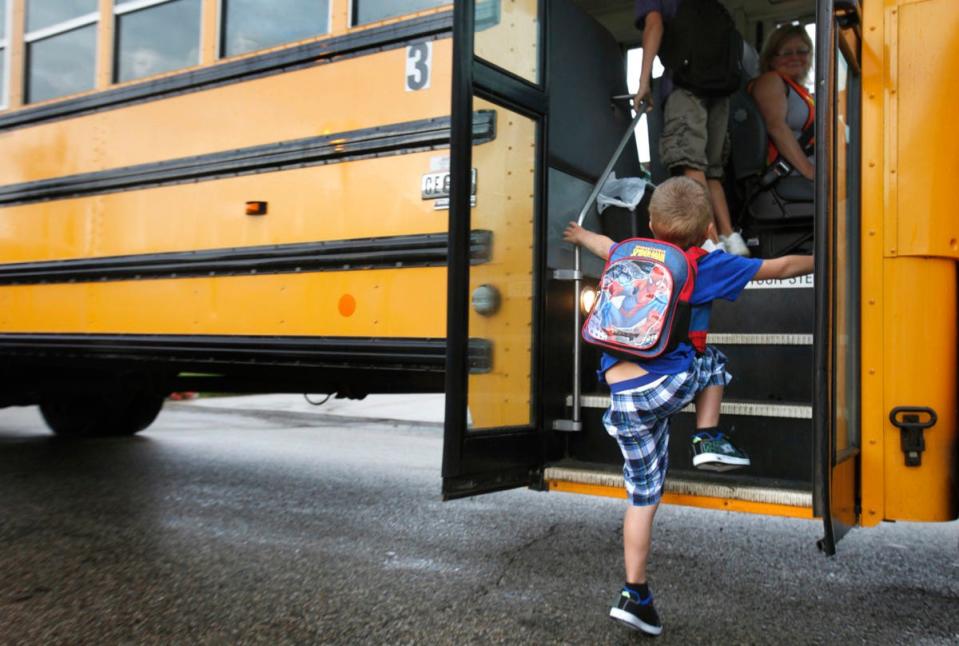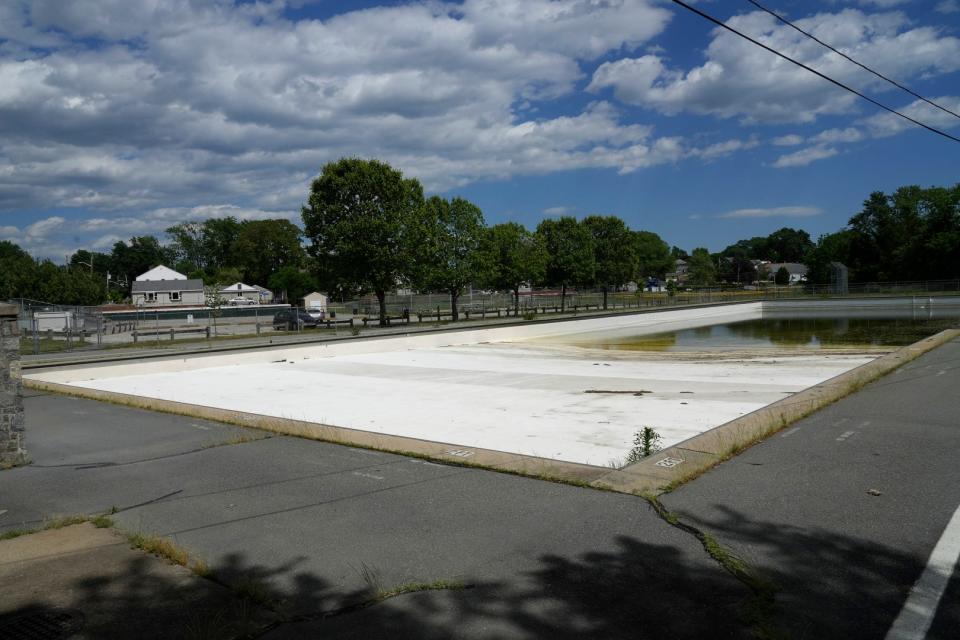RI communities have used two-thirds of ARPA money. How have they spent it?
They may never have a chance to spend on Uncle Sam's dime like this again, so how are local leaders in Rhode Island using their share of the $537 million delivered to city and town halls from the American Rescue Plan?
Well, Cumberland is starting a community health center and contributing to the Boys and Girls Club where Gov. Dan McKee coached basketball.
North Kingstown is building new pickleball courts.
Coventry repainted (green) an old railroad-turned bike path bridge that's one of the town's most recognizable landmarks, while West Warwick painted an old caboose (red) a little ways down the path.
Pawtucket is contributing $10 million toward a $124-million professional soccer stadium.
North Smithfield is using its entire windfall to fix a 1-million-gallon water tank.
And Burrillville wants to build a deck and outdoor seating area for a brew pub in Pascoag.
These are a tiny slice of the things that, more than a year and a half after President Joe Biden signed the Rescue Plan into law, these and other communities have decided to use their federal cash on.
All told, Rhode Island municipalities have spent or budgeted at least $350 million, or around two-thirds, of the ARPA money distributed to municipalities in the state, according to a Political Scene survey. And it is almost certainly an undercount as around a dozen communities, mostly smaller towns, did not respond.
Even when cities and towns decide how they want to spend their federal largesse, getting the money out the door takes time. The amount actually spent as of this month is more than $70 million.
Fortunately, cities and towns have until the end of 2024 to allocate all of their ARPA money and until 2026 to pay it out. And this doesn't count the $330 million that local school districts are getting from the Rescue Plan and have largely not spent.

Or the $1.1 billion the state government received, and budgeted all of last summer, from the pandemic stimulus bill.
So, based on where cities and towns have spent their money so far, what conclusions can we draw about where the money is going?
In Rhode Island's smaller towns, where the total dollars involved are much smaller, elected officials have mostly focused on the physical tools and trappings of local government.
When all the money has all been spoken for, expect Little League baseball diamonds, town halls, playgrounds, DPW yards, sewer pipes, storm drains, roads, municipal websites and police cruisers to be newer and slicker than they've been in a long time.
Each community's ARPA allocation is based on a population and economic-based formula favoring bigger cities to receive many times more than small towns.
Where the dollar values get larger, the plans for the money get bigger and the goals they try to achieve broader.
Nowhere is that more apparent than in Providence, where Mayor Jorge Elorza's $10-million, ARPA-funded reparations plan drew national headlines.
Rhode Island's cities have also been more likely than the small towns to use the federal cash to fill holes in their operating budgets.
Rescue Plan money can be used for "revenue replacement," a broad category that includes everything except growing a rainy day fund, pension payments and cutting taxes.
Allowed or not, using one-time cash to pay for operating expenses triggers budget hawks, who point out that it results in a problem in the future when that found money goes away.
That's especially true in this 2022-2023 budget year, when most of the economic drain from COVID shutdowns or fear is long past, as are any added municipal expenses related to the pandemic.
"The ability to ascribe money to revenue recovery was very generous," said Michael DiBiase, executive director of the Rhode Island Public Expenditure Council and former state director of administration. "You could take it and dump it in the budget, but most places didn't lose much money and the pandemic needs were taken care of by the state. It creates a structural deficit."
Over the last two fiscal years, Providence has used $47,456,790 of the $166 million it got from ARPA for budget backfill.
Cranston budgeted $27 million for revenue replacement in the past two years, although Anthony Moretti, chief of staff for Mayor Ken Hopkins, said $4 million of that has not been spent yet.
Warwick budgeted $15.4 million of its $39.4 million in ARPA funds for general use, but the $4.6 million set aside last year was ultimately not needed, city Finance Director Peder Schaefer wrote in an email.
West Warwick's ARPA budget includes $480,000 in employee stipends.
Woonsocket lists $465,000 in different bonuses to different groups of employees.
Another point of debate in ARPA spending strategy is whether and to what extent money should be dispersed outside government projects to the wider community, including nonprofits and businesses.
More than any other community, Providence is spreading its ARPA funds well beyond public infrastructure and capital projects to a wide variety of activities, groups and social programs. In addition to the reparations plan, they include funding for jobs for young people, Providence Talks child language research, non-violence training, behavioral health crisis response, PVDFest, WaterFire, tourism marketing, the Guaranteed Income Pilot Program and $2,500 small business grants.
Burrillville budgeted $25,000 of its $5 million ARPA allocation to build an outdoor seating deck at Bravo Brewing Company in Pascoag.
As Burrillville Town Manager Michael Wood explains it, the Main Street building where the brew pub rents space is owned by the the town, adding to the economic development value of the project.
However, bids for the decking came in higher than expected so the deck has not been built yet, he said Friday.
DiBiase said spreading money around to nonprofits and businesses doesn't risk creating a future budget hole, but the benefits might be short term.
"There is a tendency to spread this money thinly and that kind of lessens the overall impact," he said.
Here's a breakdown of how much cities and towns across the state have spent so far and some of what they are spending it on.
∎ Providence: $166,314,129; allocated all; spent $30,507,958
Highlights: See above.
∎ Pawtucket: $58,270,160; allocated at least $14.8 million; spent unknown
Highlights: $10 million to Tidewater Landing soccer stadium, $2 million to cover employee overtime and $266,685 "to educate voters on the vision of building a combined campus for Pawtucket's high school students." Voters overwhelmingly approved a $330-million bond to build a new Pawtucket high school in the November election.
∎ Cranston: $42,592,330; allocated $27,547,404; spent $23,106,006
Highlights: Budlong Pool, amount to be determined.

∎ Warwick: $39,431,824; allocated all, but between $5 million and $10 million has not been used and is likely to be available for fiscal 2023-2024, according to Finance Director Peder Schaefer.
Highlights: $3.5 million for new City Hall Plaza with roller rink and splash pad in Apponaug.
∎ Woonsocket: $36,388,236; allocated $15,187,030; spent $4,476,263
Highlights: $4 million for water meter replacement and $250,00 for an ice rink. Does not include funds for new police station city is going out to bid for, but has not committed to.
∎ East Providence: $27,785,912; allocated $18,536,674; spent $2,705,268
Highlights: $4 million for economic recovery including business incubators, "workshare," tourism and a storefront facade program with grants of up to $40,000 for fixing up brick and mortar businesses. Also upgrade the audio system in the City Council chamber.
∎ Cumberland: $10,540,352; allocated $9,852,501; spent $1,253,192
Highlights: The opening of a Community Health and Outreach Center for low- and moderate-income residents. Hiring an additional police officer to work on domestic violence cases. $350,000 to the Boys and Girls Club of Northern Rhode Island.
∎ Coventry: $10,407,637; allocated $649,840; spent $649,840
Highlights: Trestle Bridge Painting.
∎ West Warwick: $8,656,940; allocated $2,330,524; spent $1,979,806
Highlights: Repainting and rehabilitating the Riverpoint Caboose on the Washington Secondary Bike Path ($4,892).
∎ North Kingstown: $7,868,125; allocated $6,175,000; spent $451,500
Highlights: $3.7 million toward construction of a future recreation center/emergency shelter.
∎ Newport: $7,273,599; allocated $5,421,005; spent $1,421,005
Highlights: $2 million for neighborhood flooding remediation, $500,000 for a study of potential new buildings at Easton's Beach.
∎ Westerly: $6,689,834; allocated $4,538,313; spent $1,013,372
Highlights: $344,000 for Gingerella Skate Park, $500,000 for a "marina assessment."
∎ Smithfield: $6,545,163; allocated $3,160,000
Highlights: $1.6 million in road paving. A ribbon snow blower, a front flail mower and a scag mower.
∎ Lincoln: $6,572,065; allocated $2,158,300; spent $419,439
Highlights: Sewer Pump Station Controls Upgrade ($495,650).
∎ Bristol: $6,550,543; allocated all; spent $3,024,421
Highlights: Free public Wi-Fi for businesses and households not served by wireline internet; new HVAC in public buildings.
∎ Portsmouth: $5,148,969; allocated $4,259,218
Highlights: Remaining ARPA funds may be used to buy the Old Stone Bridge from the state.
∎ Burrillville: $5,037,776; allocated $4,731,343; spent $435,523
Highlights: $112,000 to town nonprofits.
∎ Middletown: $4,749,032; allocated all; spent $2,269,517
Highlights: All funds are going to education including the Beyond the Bell program.
∎ Tiverton: $4,681,479; allocated $4,576,769; spent $892,417
Highlights: $1.4-million radio upgrade and $1.5-million landfill closure fund.
∎ East Greenwich: $3,921,658, allocated all; spent $233,159
Highlights: Police and fire dispatch console upgrade.
∎ North Smithfield: $3,760,846; allocated all; spent $88,835
The town has allocated the entire amount to fixing the Comstock Water Tank, a 1-million-gallon tank for the Slaterville Water System.
∎ Warren: $3,141,808; allocated $1,443,451; spent $284,445
Highlights: $250,000 each for storefront improvement grants and an affordable housing trust fund.
∎ Hopkinton: $2,409,189: allocated all; spent $587,000
Highlights: Consolidation of Town Hall and new video conferencing there.
∎ Charlestown: $2,339,244; allocated $1,901,832
Highlights: $441,405 to the Charlestown Ambulance Rescue Service.
Little Compton: $1,038,402; allocated $712,838; Spent $325,563
Highlights: $445,000 in repairs to municipal buildings
∎ Block Island: $302,198; allocated and spent none
Towns not listed did not respond

This article originally appeared on The Providence Journal: RI communities have used two-thirds of ARPA money. How have they spent it?

